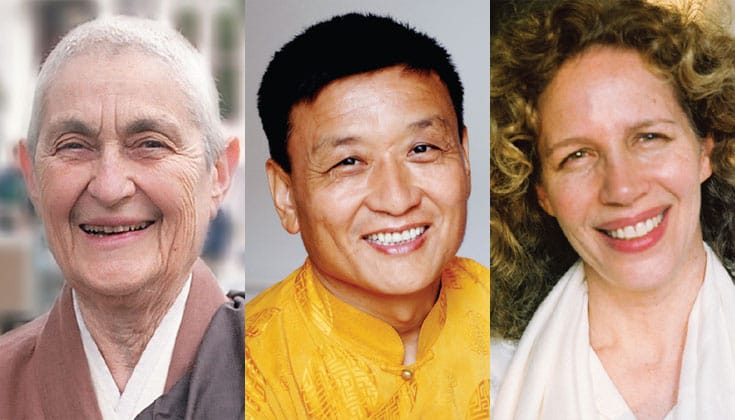Question: Do buddhas think?
Narayan Helen Liebenson: As I understand it, the awakened mind includes thinking; it’s just that the thinking is necessary, functional, and discerning rather than indulgent, unnecessary, and addictive. Without attachment to thinking, silence and peace are available. In not grasping after thoughts and taking them to be me and mine, there is freedom instead of bondage.
Buddhas plan, but don’t engage in worry. They make decisions but are not swayed by self-centered emotions. Buddhas are immeasurably creative but not interested in fantasy. Buddhas think but are not caught up in their thoughts, and do not mistake their thoughts to be who they are. They are present in the midst of thoughts arising, and use thinking as a way to benefit all beings.
A common misconception in dharma practice is that meditation means striving to eliminate thoughts or that silence means there are no thoughts. Struggling or fighting with thoughts causes tension and out of tension comes doubt. Buddhas don’t try to get rid of thoughts; they let thoughts arise and pass. The result of letting go of attachment to thinking is greater access to wisdom.
A significant aspect of Buddhist practice involves learning to let go. Letting go frees energy and creates a space to explore and investigate the nature of suffering and liberation. Wise effort in practice involves developing a wise relationship to thought, allowing thinking to be creative and discerning. Without awareness, thoughts are conditioned by habit. The key is to be neither entranced nor repelled, identified or reactive. So we are not trying to not think; rather we are learning that it is possible to be quiet and to allow thoughts to come and go as a natural aspect of life.
The work of meditation is to learn how to use thought wisely and not be used by it. We learn to release our habitual preoccupations and delight in remaining undistracted. We suffer because we are deluded by our thoughts, investing our identity in each thought that comes along. But thought itself is not a problem. Buddhas know that a thought is just a thought and rest in true and abiding peace.
Zenkei Blanche Hartman: The short answer is, yes, buddhas do think. However, I have a bumper sticker on my car that says, “Don’t believe everything you think,” because so often we identify with our thoughts and set up a self there. We can become quite emotional about being “right” and get into heated arguments and conflicts defending our point of view.
Perhaps if we’ve been told in meditation instruction not to get carried away by our thoughts, we get the idea that we are supposed to stop thinking. A student once said to Suzuki Roshi, “I just can’t stop thinking. What should I do?” Roshi replied, “Is there some problem with thinking?”
The Pali Canon is a vast collection of examples of how Shakyamuni Buddha thought; and all of the vast literature of teaching and commentary over the last 2,500 years from Buddha ancestors of many countries and cultures are examples of how a buddha thinks. A buddha’s intention is to free beings from suffering and distress, so he or she clearly observes which actions of body, speech, and mind lead to peace and happiness and which lead to misery, and teaches others what he or she has discovered. It is up to us, then, to train ourselves to relinquish thinking that leads to suffering and to cultivate thinking that leads to happiness.
For example, in the Dhammapada, Shakyamuni Buddha teaches:
All experience is preceded by mind, led by mind, made by mind.
Speak or act with a corrupted mind, and suffering follows
As the wagon wheel follows the hoof of the ox.
All experience is preceded by mind, led by mind, made by mind.
Speak or act with a peaceful mind and happiness follows
Like a never departing shadow.
“He abused me, attacked me, defeated me, robbed me!”
For those carrying on like this, hatred does not end.
“She abused me, attacked me, defeated me, robbed me!”
For those not carrying on like this, hatred ends.
Our effort in zazen is to observe our own thinking and to notice any habitual thought patterns, for example, how often first person pronouns (e.g. I, me, mine) show up. We might notice that in our mind we often set up a boundary between “this” and “that” or “me” and “not me” or “self” and “other.” We could explore just where such a boundary is, or if there really is such a boundary outside our thoughts. Could we make it bigger to include more? Could we let it expand to include the whole universe? Or we might notice a habitual tendency toward self-deprecation or self-aggrandizement, or a tendency to make judgments about others. Then we can observe whether any of these habitual thought patterns result in peace or stress.
As soon as we notice a stressful thought—such as greed, grasping, craving, envy, aversion, ill will, anger, fear, hatred, or delusion—we can train ourselves to recognize it as unwholesome and let it go.
As soon as we notice a wholesome thought—such as connection, love, kindness, compassion, empathetic joy, equanimity, gratefulness, generosity, enthusiasm, or devotion—we can train ourselves to recognize it as wholesome and cultivate it.
“Who is it that notices these thoughts as wholesome or unwholesome and responds for the benefit of all beings?” This is an example of how a buddha or bodhisattva thinks.
As we observe our mind at work, notice that it isn’t what comes up, but how we think about it that makes all the difference for ourselves and all beings.
Tenzin Wangyal Rinpoche: From the sutric viewpoint, “thinking” is the mind that grasps its object through meaning or sound. For example, when we say “apple,” our thought grasps an image of an apple because we have associated meaning with that word and we grasp that in our mind. When we say, “I” or “me,” we may identify ourselves with a title, status, sex, religion, or even with pain—all of which involves the moving mind, or thought. If thought is not there, we are not able to grasp. Samsara, or the suffering of existence, is the result of grasping. By definition, a buddha—one who is free of the suffering of existence—does not have a grasping mind. Since a buddha does not grasp, a buddha does not have thoughts.
A buddha’s perception is pure awareness, or rigpa, which is not a product of the moving, thinking mind, but is direct perception. Thought can never experience the true nature of mind directly, so in Dzogchen, thought is not encouraged since it will not liberate us from suffering. And while conventionally we could agree that the thought to benefit another is preferable to the thought of jealousy, in order to achieve full realization one needs even to be free of positive thoughts because of their involvement with the grasping mind.
The grasping mind is the source of suffering. Wherever there is grasping mind, there is pain and insecurity. But we are so familiar with this discomfort that the familiarity itself is comforting and we often do not see our thinking as an expression of pain. In fact, we are convinced that by improving our thinking, and thereby the results of our thoughts, we will experience a better life.
If we are willing to recognize that thoughts are an expression of suffering, should we then declare a war on thoughts and attempt to get rid of them? This is not what the dharma advises.
According to the teachings, to turn our pain into a path, we must use thoughts as the doorway to realize the thought-free. Basically thought is used to support one’s path not through smarter or better thinking but through direct observation, which does not involve thought. We look directly at the mind that thinks. Where does thought come from? Where does it go? Where is the mind? Who is thinking? Who is observing thinking? When you look directly at the mind itself, you cannot find anything, and in what you cannot find, you abide.
Thought is the moving mind and not the nature of mind. You can think anything. You can create anything. When we allow thoughts, we can create incredible stories that make us laugh and make us cry. The more we identify with our stories and the one creating the stories, the more we are trapped in our pain. And freeing oneself from pain is not a matter of finding a better story. Instead, we must find the storyteller. Yet when we search for this storyteller, we cannot find anything solid that is itself not just another story.
As we look directly, precisely, and nakedly at the thoughts, they cannot remain. As they dissolve, we may become aware of an observer of thoughts. So, we look directly and nakedly at this observer. Again, even the observer dissolves and what remains is open and clear. There we abide in open awareness. Looking directly at our thoughts without further elaboration, we find that thought is like a cloud that dissolves into the sky. We refer to this sky as the base of all, the source, or the great mother. With the absence of thought we see this space more clearly than with the presence of thought. But thought gives us a contrast experience, a doorway to discover the boundless space of being, which is not a product of the moving, thinking mind and is not experienced by this moving mind. The unbounded space of being is directly and nakedly perceived by awareness itself, rigpa. Because awareness and space are not separate, they are referred to as union. This union spontaneously gives birth to positive qualities, such as compassion.
So in meditation practice, don’t do anything. Allow thought; it will dissolve. If it is not dissolving, observe nakedly and see it dissolve. As we meditate, we become more and more familiar with the openness we experience as our grasping dissolves. In this way, we recognize our true nature as buddha and positive qualities are naturally and spontaneously available for the benefit of others.

